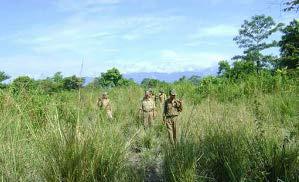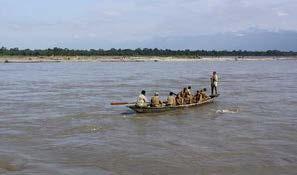Jayanta Das
Other projects
Dehing Patkai Wildlife Sanctuary is the strong holds of Hoolock gibbon recently (2004) added to Protected Area Network. But despite being officially upgraded as WLS, the infrastructure of the Sanctuary is very poor with insufficient staff and facilities. Villages surrounded the sanctuary and fringe villagers are more or less dependent on forest for their livelihood. Lack of knowledge and motivation among the forest staff to combat illegal activities and lack of awareness among local people about the importance of the sanctuary are the major challenges. In such situation, any unilateral conservation effort seems to be insufficient to save Hoolock gibbon population and its rainforest habitats. This emerged the need to broaden the conservation efforts through conservation education and activism.

Uniformed volunteers along with the Home guards near Uchila Camp.
In the current exercise we are catalyzing the Rufford Small Grant to provide some basic facilities to front line forest staffs like field kits to perform anti-poaching, anti-smuggling activities within the sanctuary. So far e provide 15 numbers of field kits to Joypur Range staffs of Dehing Patkai Wildlife Sanctuary that include sleeping bags, field dress, field bags, shoes, leech guard, rain coat, torch, cap etc. In the same time we will give another 18 numbers of filed kits to Patkai Range staffs of Dehing Patkai Wildlife Sanctuary. At the same time as a part of the program, the front line staff will also be oriented with legal aspects of tackling poachers and timber smugglers within the sanctuary by organising a legal orientation camp, which will be done very shortly.

River patrolling by the Volunteers in Bansbari Range
While Hoolock gibbon plays an important role in ecosystem functioning and represents flagship species of tropical woodland forest, while aesthetically it has a tremendous value. So, by promoting gibbon will satisfied the minimum requirements for a group of species and feed the sentiment of local people as well as help to generate awareness, which will help to foster management in preserving the key landscape. So, we have already organised three field conservation education camp targeting schools, colleges and other educational institution in the surrounding areas. Each camps were organised for two days including audio visual presentation as well as different participatory activities and field trips to introduce the gibbon and its problems related to habitat loss and hunting. So far 250 students as well as local youth, elders have been attending the camps.